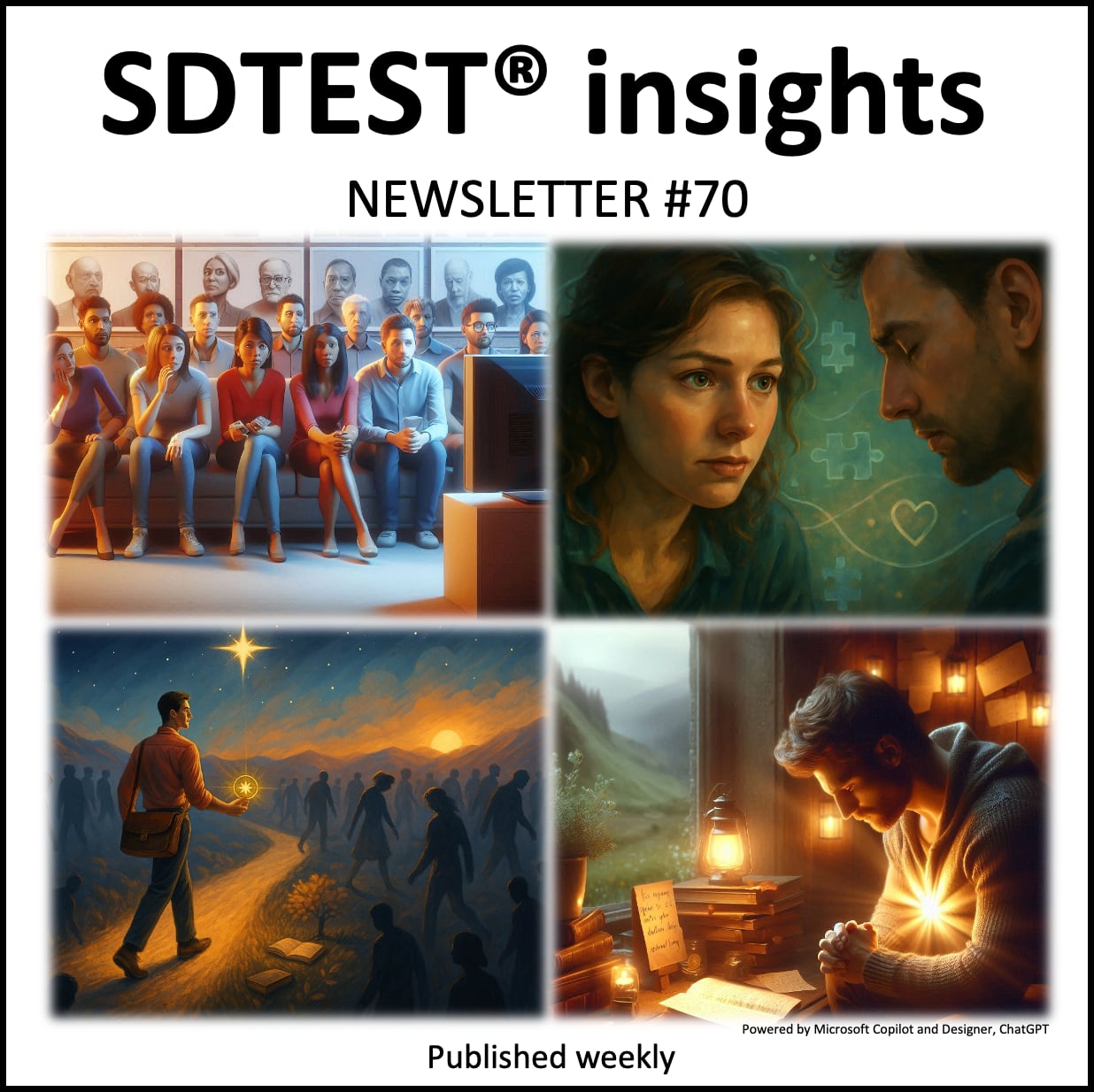SDTEST® has 38 different VUCA polls that calculate the 13,643 correlation values between stages of development according to the theory of Spiral Dynamics and answer options of these 38 polls.
We invite curiosity about the systemic mechanisms behind this correlation. There may be hidden variables that provide alternative explanations.
In our analysis of the poll "Trust" (by WVS), [Could you tell us how much confidence you have in organizations?], we found an intriguing negative linear correlation that warrants closer examination:
-0.1090 (Pearson) between the Television / None at all and the Purple stage.
The critical value of the correlation coefficient for a normal distribution, by William Sealy Gosset (Student), is r = 0.0605. Nevertheless, this negative linear correlation of -0.1090 meets the reliability criteria but does not necessarily imply causation.
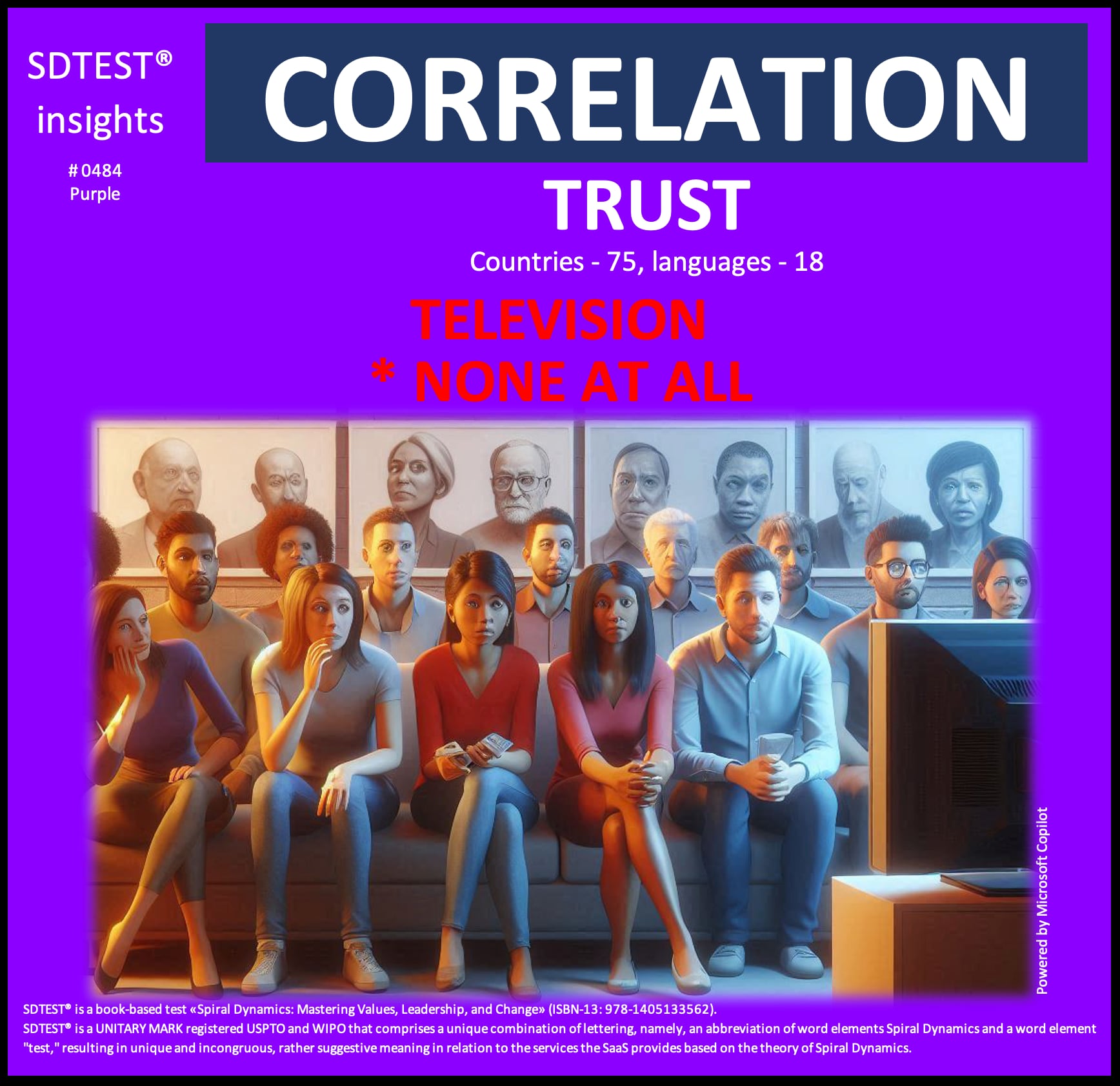
This negative correlation of -0.1090 between "Television / None at all" and the Purple stage offers fascinating insights when viewed through the lens of the Purple value system:
Organizational Perspective:
Organizations operating within the Purple mindset might interpret this correlation as:
- Confirmation that traditional media channels like television serve as modern tribal storytellers, preserving and transmitting communal wisdom.
- Validation that respecting established information authorities aligns with honoring ancestral guidance systems.
- Evidence that rejecting television contradicts the Purple value of accepting communal information sources.
These organizations might respond by:
- Creating rituals around shared television viewing experiences to strengthen group bonds.
- Consulting elders about which television programs best reflect tribal values before recommending them.
- Using television as a modern "sacred fire" around which community members gather for shared experiences.
Team Perspective:
Teams operating from a Purple mindset might approach this correlation by:
- Viewing television as a modern oracle that connects the team to the wider world's wisdom.
- Interpreting it as validation for using shared media experiences to build team cohesion and identity.
- Seeing television as an extension of traditional storytelling that preserves important cultural narratives.
These teams might respond by:
- Establishing team rituals that incorporate watching significant television events together.
- Trusting television personalities as modern clan leaders who provide guidance from beyond the immediate circle.
- Creating taboos around criticizing shared television experiences that unify the team.
Individual Perspective:
Individuals aligned with the Purple value system might interpret this correlation as:
- Personal validation of their trust in television as a connection to broader tribal knowledge.
- Evidence supporting their belief that respecting established information sources honors ancestral wisdom.
- Confirmation that skepticism toward television would separate them from communal knowledge and identity.
These individuals might respond by:
- Viewing television watching as a spiritual practice that connects them to their community.
- Treating trusted television personalities as wise elders who provide guidance and maintain tradition.
- Seeing television skeptics as potentially dangerous to group harmony and collective wisdom.
This correlation, viewed through the Purple lens, suggests that those operating at the Purple level may be more likely to trust television as an authority. It implies that the Purple value system's emphasis on tradition, community wisdom, and shared tribal knowledge aligns with a greater acceptance of established media institutions.
The reasons why Purple-stage individuals might trust television "A great deal" could include:
- Sacred Authority: Television represents a modern form of tribal storytelling from trusted authorities.
- Communal Bonding: Shared television experiences create rituals that strengthen group identity and belonging.
- Mystical Connection: Television brings distant wisdom and events into the tribal circle, similar to how shamans connect with external forces.
- Ancestral Continuation: Trusting established institutions like television honors the tradition of respecting community knowledge sources.
- Fear of Exclusion: Rejecting television might represent separation from the tribe's shared reality and collective wisdom.
This correlation highlights how the Purple value system's emphasis on tradition, belonging, and mystical connections influences trust in media institutions. It raises questions about how different value systems approach information sources and what constitutes legitimate authority in different developmental stages.
Ultimately, this correlation highlights the complex interplay between cultural values, trust mechanisms, and information sources. Television might be seen not just as a medium but as a sacred connector to collective wisdom and shared reality in Purple-dominant environments.
In our analysis of the poll "Empathy is," we found an intriguing positive linear correlation that warrants closer examination:
0.1116 (Pearson) between the Identify how a person is feeling / Strongly Disagree and the Red stage.
The critical value of the correlation coefficient for a non-normal distribution, by Spearman, is r = 0.0025. Nevertheless, this positive linear correlation of 0.1116 meets the reliability criteria but does not necessarily imply causation.
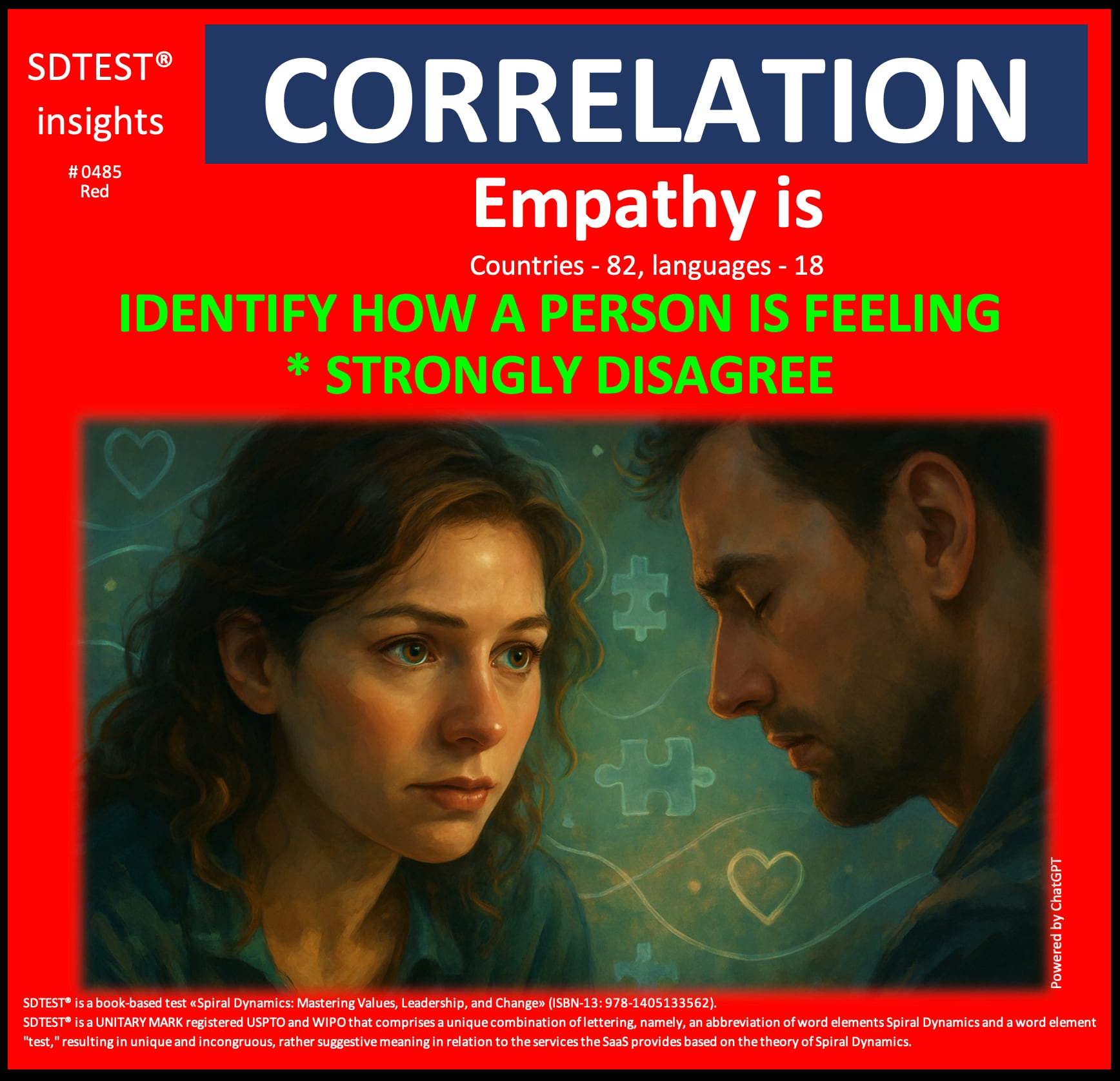
This positive correlation of 0.1116 between "Identify how a person is feeling / Strongly Disagree" and the Red stage offers intriguing insights when viewed through the lens of the Red value system:
Organizational Perspective:
Organizations operating within the Red mindset might interpret this correlation as:
- Validation of their power-driven approach, where understanding others' feelings is irrelevant to achieving dominance.
- Confirmation that emotional awareness is a weakness that distracts from asserting authority and control.
- Evidence supporting their belief that action and strength trump emotional intelligence in organizational success.
These organizations might respond by:
- Reinforcing cultures where displays of power and dominance are rewarded over emotional awareness.
- Implementing systems that prioritize immediate results over understanding stakeholder feelings.
- Promoting leaders who make decisive, self-serving decisions without concern for others' emotional responses.
Team Perspective:
Teams operating from a Red mindset might approach this correlation by:
- Viewing it as an affirmation that emotional awareness impedes the competitive edge needed for team success.
- Interpreting it as support for their belief that understanding feelings creates unnecessary vulnerability.
- Seeing it as validation for prioritizing competition, immediate gratification, and individual achievement over empathy.
These teams might respond by:
- Creating environments where team members compete rather than connect emotionally.
- Encouraging forceful self-expression without regard for others' feelings or reactions.
- Celebrating those who act boldly and impulsively rather than those who pause to consider emotional impacts.
Individual Perspective:
Individuals aligned with the Red value system might interpret this correlation as:
- Personal validation of their aggressive, self-focused approach to interactions.
- Evidence supporting their belief that understanding others' feelings provides no advantage.
- Confirmation that their impulsive, desire-driven behavior is more effective than emotional consideration.
These individuals might respond by:
- Actively dismissing emotional awareness as irrelevant to personal power and success.
- Viewing empathy as a threat to their assertive self-expression and dominance.
- Using emotional indifference as a strategy to maintain power in relationships and situations.
This correlation, viewed through the Red lens, suggests that those operating at the Red level may be less likely to value identifying how others feel. It implies that the Red value system's emphasis on power, impulsiveness, and self-centered behavior aligns with a rejection of empathy as a valuable skill.
The reasons why Empathy might not be seen as identifying how a person is feeling in the Red stage could include:
- Power Prioritization: Understanding others' feelings is irrelevant when the goal is dominance and control.
- Vulnerability Avoidance: Emotional awareness might be perceived as creating unnecessary vulnerability.
- Immediate Gratification: The focus on immediate desires leaves little room for the patience required in empathic understanding.
- Competitive Advantage: Dismissing others' feelings can be seen as maintaining an edge in competitive situations.
- Self-Centered Worldview: In a Red mindset, only one's own feelings and desires truly matter.
This correlation prompts us to consider how different value systems influence perceptions of emotional intelligence and interpersonal dynamics. It raises questions about the potential benefits and drawbacks of a Red approach to empathy within organizations, particularly in contexts where relationship building and collaborative problem-solving are crucial.
Ultimately, this correlation highlights the complex interplay between value systems, interpersonal dynamics, and emotional intelligence. Empathy might be seen not as a strength but as an unnecessary and potentially limiting trait in Red-dominant environments.
In our analysis of the poll "Psychological Wellbeing" (by Carol D. Ryff), we found an intriguing positive linear correlation that warrants closer examination:
0.1335 (Pearson) between the Purpose in life. Some people wander aimlessly through life, but I am not one of them / Strongly agree, and the Blue stage.
The critical value of the correlation coefficient for a normal distribution, by William Sealy Gosset (Student), is r = 0.048. Nevertheless, this positive linear correlation of 0.1335 meets the reliability criteria but does not necessarily imply causation.
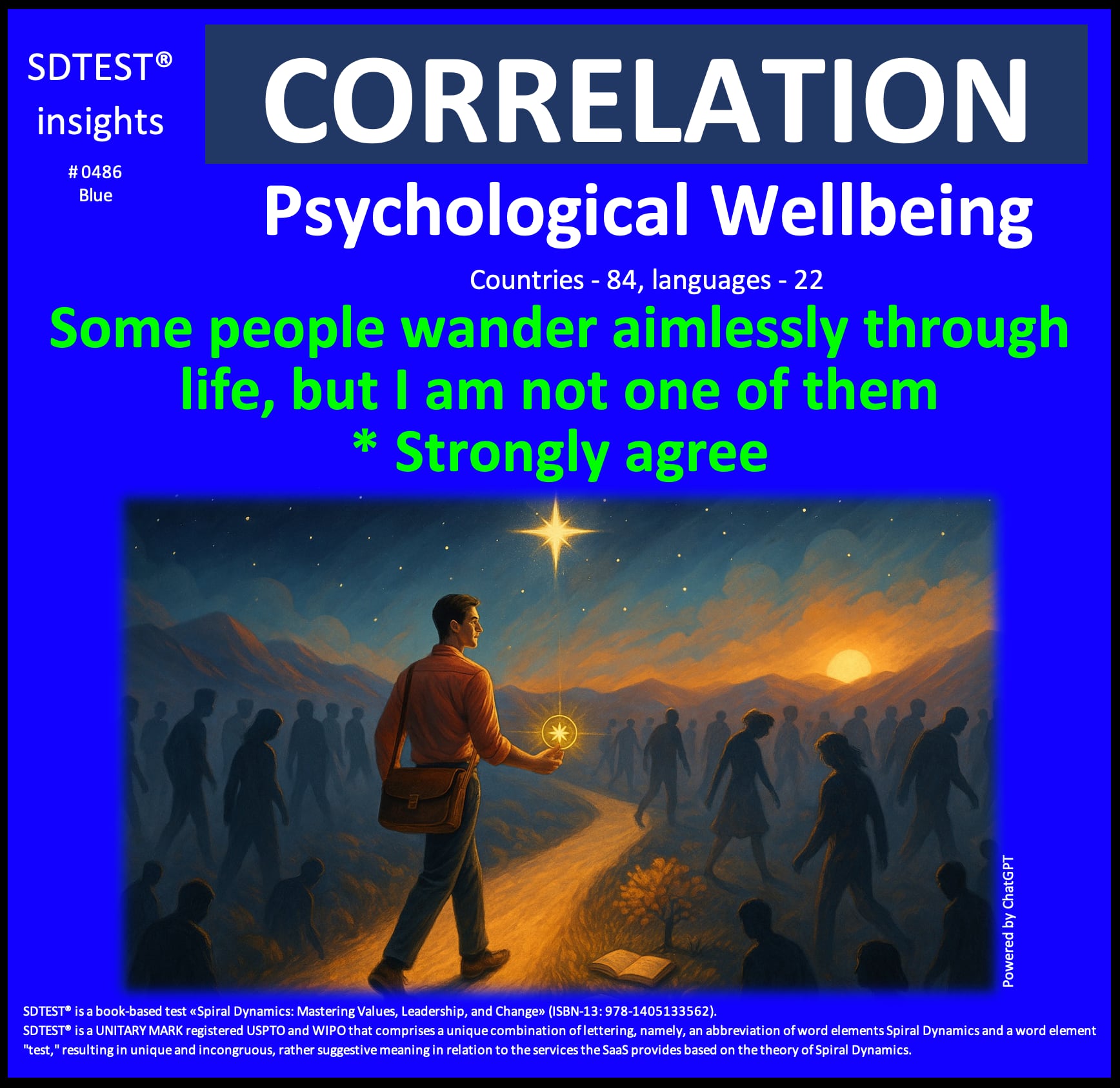
This positive correlation of 0.1335 between "Purpose in life. Some people wander aimlessly through life, but I am not one of them / Strongly agree" and the Blue stage offers intriguing insights when viewed through the lens of the Blue value system:
Organizational Perspective:
Organizations operating within the Blue mindset might interpret this correlation as:
- Validation of their structured, orderly approach to organizational purpose and mission.
- Confirmation that clear hierarchies, rules, and procedures provide meaningful direction to members.
- Evidence supporting their belief that adherence to established codes creates purposeful organizational identity.
These organizations might respond by:
- Strengthening formal mission statements and organizational credos that guide all activities.
- Implementing more rigorous systems that align individual roles with the greater organizational purpose.
- Promoting leaders who embody unwavering dedication to organizational values and traditions.
Team Perspective:
Teams operating from a Blue mindset might approach this correlation by:
- Viewing it as affirmation that proper structure and clear authority prevent purposeless drift.
- Interpreting it as support for their belief that team discipline creates meaningful collective direction.
- Seeing it as validation for strict adherence to protocols that provide clear purpose to team efforts.
These teams might respond by:
- Creating more detailed procedural manuals that connect daily tasks to higher organizational purposes.
- Establishing team rituals that reinforce commitment to shared duty and collective mission.
- Celebrating members who demonstrate unwavering loyalty to team objectives and procedures.
Individual Perspective:
Individuals aligned with the Blue value system might interpret this correlation as:
- Personal validation of their disciplined, duty-bound approach to life.
- Evidence supporting their belief that following righteous rules provides proper life direction.
- Confirmation that rejecting impulsivity in favor of traditional values creates meaningful existence.
These individuals might respond by:
- Redoubling their commitment to moral codes that provide clear life guidance.
- Viewing their rejection of aimless wandering as moral superiority over those without structure.
- Seeking more opportunities to demonstrate loyalty to institutions that reinforce their sense of purpose.
This correlation, viewed through the Blue lens, suggests that those operating at the Blue level may be more likely to strongly identify with having clear purpose in life. It implies that the Blue value system's emphasis on order, duty, and moral certainty aligns with a stronger sense of life direction and purpose.
The reasons why people in the Blue stage might strongly agree with having purpose rather than wandering aimlessly could include:
- Moral Imperative: Following a divinely ordained or traditionally established path provides clear direction.
- Duty Fulfillment: Adhering to established roles and responsibilities creates inherent purpose.
- Structural Clarity: Clear hierarchies and rules eliminate the confusion of having to determine one's own direction.
- Righteous Identity: Being purposeful represents moral superiority over the "wanderers" who lack proper guidance.
- Institutional Belonging: Purpose comes from faithful service to established institutions and traditions.
This correlation prompts us to consider how different value systems influence perceptions of purpose and meaningful existence. It raises questions about the relationship between structured belief systems and psychological well-being, particularly in contexts where certainty and clear direction are highly valued.
Ultimately, this correlation highlights the complex interplay between cultural values, personal identity, and existential fulfillment. Having clear purpose might be seen not just as a psychological state but as a moral virtue and sacred duty in Blue-dominant environments.
In our analysis of the poll "How Do You Regulate Your Emotions?" (by Nawal Mustafa [1]), we found an intriguing positive linear correlation that warrants closer examination:
0.4468 (Pearson) between the When I feel DISCOURAGED. I will be kind to myself and remind myself of the reason why I am trying. I will use that as my strength / Strongly Agree, and the Orange stage (USA, 3 languages).
The critical value of the correlation coefficient for a normal distribution, by William Sealy Gosset (Student), is r = 0.3671. Nevertheless, this positive linear correlation of 0.4468 meets the reliability criteria but does not necessarily imply causation.
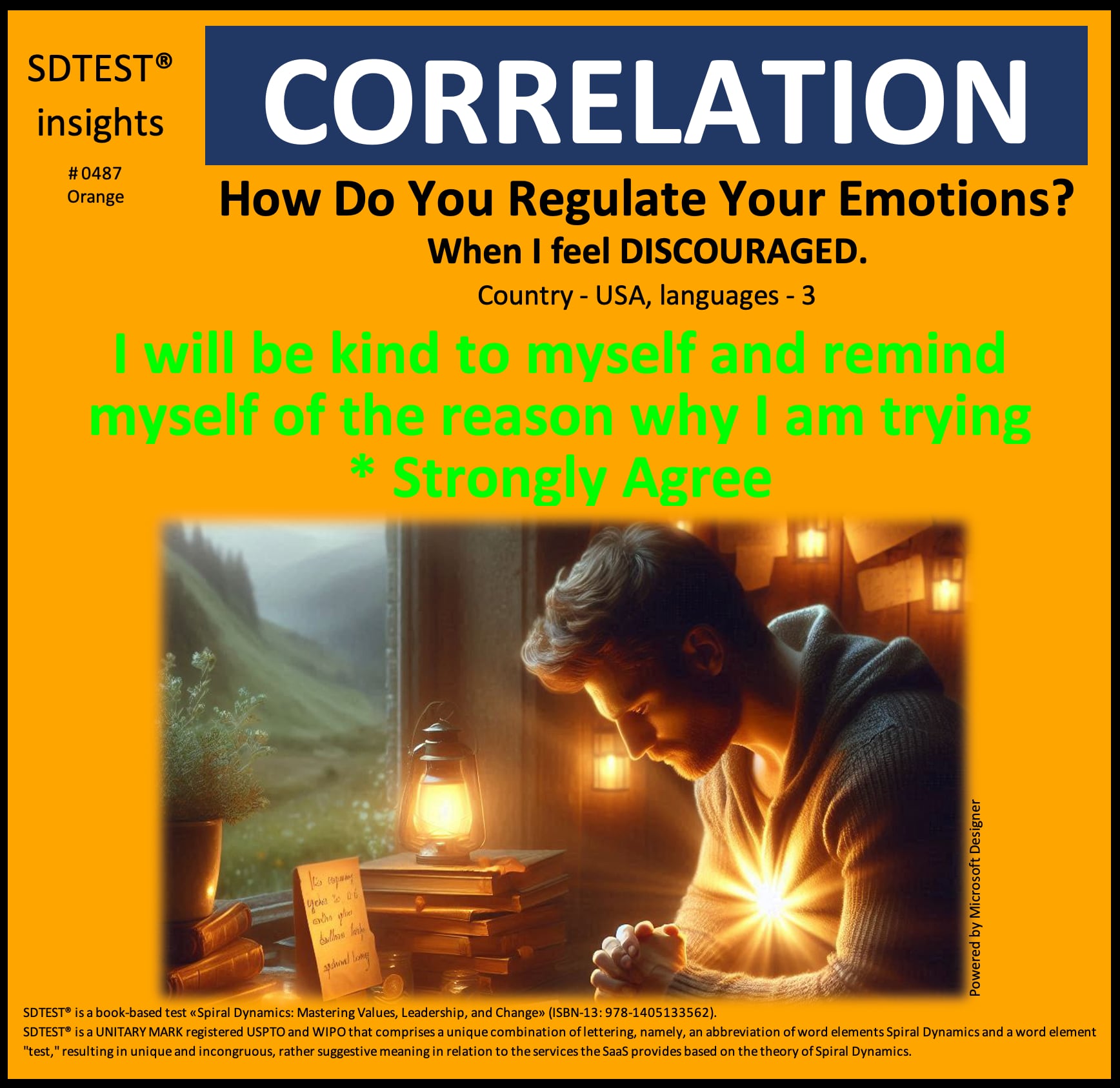
This positive correlation of 0.4468 between "When I feel DISCOURAGED. I will be kind to myself and remind myself of the reason why I am trying. I will use that as my strength / Strongly Agree" and the Orange stage in the USA offers intriguing insights when viewed through the lens of the Orange value system:
Organizational Perspective:
Organizations operating within the Orange mindset might interpret this correlation as:
- Validation of their achievement-oriented approach where self-motivation and emotional resilience are strategic advantages.
- Confirmation that rational self-encouragement leads to improved performance and competitive edge.
- Evidence supporting their belief that strategic emotional management can be leveraged for greater efficiency and productivity.
These organizations might respond by:
- Implementing science-based resilience training programs that focus on goal-oriented self-encouragement.
- Creating performance management systems that incorporate metrics for emotional regulation as a productivity driver.
- Promoting leaders who demonstrate both achievement focus and strategic emotional intelligence.
Team Perspective:
Teams operating from an Orange mindset might approach this correlation by:
- Viewing it as affirmation that teams who practice strategic self-encouragement outperform those who don't.
- Interpreting it as support for their belief that emotional regulation can be optimized through rational analysis.
- Seeing it as validation for developing systematic approaches to maintain motivation in competitive environments.
These teams might respond by:
- Adopting data-driven methods to measure and improve team resilience through goal-clarity techniques.
- Engineering team processes that include strategic self-encouragement as part of project management.
- Creating meritocratic recognition systems that reward both achievement and effective emotional management.
Individual Perspective:
Individuals aligned with the Orange value system might interpret this correlation as:
- Personal validation of their strategic approach to self-motivation as a competitive advantage.
- Evidence supporting their belief that rational emotional management enhances performance.
- Confirmation that connecting discouragement to clearly defined goals produces optimal outcomes.
These individuals might respond by:
- Analyzing their emotional responses as data points to be optimized for greater personal effectiveness.
- Viewing self-encouragement as a technological tool to be refined for maximum productivity.
- Using empirical methods to test which self-motivation techniques yield the best performance results.
This correlation, viewed through the Orange lens, suggests that those operating at the Orange level in the USA may be more likely to employ strategic self-encouragement when discouraged. It implies that the American Orange value system's focus on achievement, rationality, and efficiency aligns with a pragmatic approach to emotional management.
The reasons why people in the Orange stage in the USA might strongly agree with being kind to themselves and focusing on reasons for trying when discouraged could include:
- American Individualism: In the USA's highly individualistic culture, self-reliance in emotional management aligns with cultural values of personal responsibility.
- Entrepreneurial Mindset: The American entrepreneurial spirit views setbacks as learning opportunities requiring strategic resilience.
- Productivity Culture: The USA's strong emphasis on productivity and efficiency demands effective techniques to overcome discouragement quickly.
- Competitive Market Economy: In the USA's highly competitive business environment, maintaining motivation through setbacks provides measurable market advantage.
- American Pragmatism: The distinctly American philosophical tradition of pragmatism values emotional techniques based on their practical outcomes rather than abstract principles.
This correlation prompts us to consider how uniquely American expressions of the Orange value system influence approaches to emotional regulation and resilience. It raises questions about the relationship between American achievement orientation and strategic self-compassion, particularly in the USA's performance-driven cultural context where outcomes and success are paramount.
Ultimately, this correlation highlights the complex interplay between distinctly American cultural values, emotional management strategies, and performance optimization. In Orange-dominant American environments, self-encouragement might be seen not as a feel-good exercise but as a pragmatic, evidence-based strategy for maintaining momentum toward the American dream of measurable success and achievement.
-0.2071 (Pearson) between the Job specialty - Sales and the Green stage.
The critical value of the correlation coefficient for a normal distribution, by William Sealy Gosset (Student), is r = 0.18. Nevertheless, this negative linear correlation of -0.2071 meets the reliability criteria but does not necessarily imply causation.

This negative correlation of -0.2071 between "Job specialty - Sales" and the Green stage offers intriguing insights when viewed through the lens of the Green value system:
Organizational Perspective:
Organizations operating within the Green mindset might interpret this correlation as:
- Validation of their people-first approach, where collaborative technology creation is prioritized over transactional sales relationships.
- Confirmation that holistic IT development should focus on community needs rather than profit-driven sales objectives.
- Evidence supporting their belief that sustainable technology solutions emerge from consensus-building rather than competitive sales cultures.
These organizations might respond by:
- Restructuring IT departments to minimize sales-oriented metrics in favor of community impact assessments.
- Implementing hiring practices that prioritize collaborative mindsets over sales-driven personalities.
- Promoting participatory technology development models where users are partners rather than customers.
For profit-oriented businesses recognizing this correlation, the strategic response might include:
- Deliberately placing Green-oriented IT specialists in product development, user experience, and community engagement roles where their values create competitive advantage.
- Reserving sales positions for those with Orange or Blue value orientations who thrive in achievement-driven or structured environments.
- Creating bridges between Green-dominated development teams and sales departments to ensure authentic communication of product values to the market.
Team Perspective:
Teams operating from a Green mindset might approach this correlation by:
- Viewing it as an affirmation that inclusive, consensus-based IT work stands at odds with the competitive nature of sales.
- Interpreting it as support for their belief that technology should be developed through shared understanding rather than sold through persuasion.
- Seeing it as validation for creating more equitable, non-hierarchical structures where sales-driven dynamics are minimized.
These teams might respond by:
- Creating collaborative spaces where IT specialists can develop user relationships based on mutual understanding.
- Establishing team processes that value diverse perspectives over sales targets or competitive achievements.
- Celebrating contributions that enhance community well-being rather than those that drive sales figures.
Individual Perspective:
Individuals aligned with the Green value system might interpret this correlation as:
- Personal validation of their discomfort with the transactional, sometimes manipulative nature of sales roles.
- Evidence supporting their belief that technology should serve community well-being rather than market dominance.
- Confirmation that their authentic self-expression is better aligned with collaborative technology creation than competitive selling.
These individuals might respond by:
- Seeking roles that allow them to develop technology through inclusive, consensus-based processes.
- Viewing sales-oriented positions as potentially compromising their values of equality and authenticity.
- Gravitating toward opportunities where they can build genuine connections rather than transactional relationships.
This correlation, viewed through the Green lens, suggests that those operating at the Green level may be less attracted to sales-focused IT roles. It implies that the Green value system's emphasis on community, consensus, and authentic relationships may conflict with traditional sales approaches.
The reasons why a Job specialty - Sales might not be preferred by IT specialists in the Green stage could include:
- Value Misalignment: Sales often emphasizes individual achievement and competition, conflicting with Green values of cooperation and community.
- Relationship Authenticity: Green-oriented individuals may perceive sales relationships as transactional rather than authentic connections.
- Purpose Orientation: Green IT specialists typically seek meaningful impact over profit-driven objectives associated with sales roles.
- Consensus vs. Persuasion: The sales process often involves persuasion techniques that may feel manipulative to those valuing open dialogue and consensus.
- Systems Thinking: Green IT specialists tend to view technology as part of interconnected systems rather than discrete products to be sold.
This correlation prompts us to consider how different value systems influence career preferences within the IT field. It raises questions about the potential benefits and drawbacks of a Green approach to technology development and dissemination, particularly in contexts where stakeholder needs and community impact are prioritized over market growth.
Ultimately, this correlation highlights the complex interplay between value systems, professional roles, and organizational structures in the technology sector. The aversion to sales specialties might reflect a deeper Green commitment to reimagining how technology serves humanity, not as products to be sold, but as collaborative solutions emerging from inclusive, consensus-based processes that honor the needs of all stakeholders.
From a profit-oriented business perspective, this correlation offers valuable insights for strategic talent allocation. Rather than fighting against these natural value inclinations, forward-thinking companies might create balanced organizational ecosystems where Green-oriented IT specialists drive innovation, user-centered design, and sustainable solutions, while team members with different value orientations handle the necessary sales functions. This recognition of diverse value systems as complementary rather than competing can transform a potential conflict into a strategic advantage that enhances both profit margins and positive social impact.
In our analysis of the poll "Ageism in life," we found an intriguing positive linear correlation that warrants closer examination:
0.0872 (Pearson) between the Yes, I have seen someone being treated differently because of their age, and the Yellow stage.
The critical value of the correlation coefficient for a normal distribution, by William Sealy Gosset (Student), is r = 0.0768. Nevertheless, this positive linear correlation of 0.0872 meets the reliability criteria but does not necessarily imply causation.

This positive correlation of 0.0872 between witnessing age-based differential treatment and the Yellow stage offers fascinating insights when viewed through the lens of the Yellow value system:
Organizational Perspective:
Organizations operating within the Yellow mindset might interpret this correlation as:
- Validation of their systems-thinking approach that recognizes age diversity as a complex societal pattern requiring integration.
- Confirmation that their heightened awareness of social dynamics enables them to perceive subtle forms of discrimination that others might miss.
- Evidence supporting their belief that acknowledging problems is the first step toward transcending them.
These organizations might respond by:
- Implementing age-diverse mentoring networks that flow in multiple directions (not just older-to-younger).
- Creating flexible work environments that adapt to different life stages and experience levels.
- Developing comprehensive frameworks that honor the contributions of all age groups while addressing systemic biases.
Team Perspective:
Teams operating from a Yellow mindset might approach this correlation by:
- Viewing it as confirmation of their ability to detect nuanced social dynamics that others might overlook.
- Interpreting it as supporting their integrative approach to team composition and knowledge sharing.
- Seeing it as validation for their holistic understanding of how age intersects with other aspects of identity and experience.
These teams might respond by:
- Facilitating open dialogues about age-related assumptions without judgment or blame.
- Creating collaborative projects that specifically leverage cross-generational insights.
- Developing team practices that honor both innovation and wisdom regardless of their source.
Individual Perspective:
Individuals aligned with the Yellow value system might interpret this correlation as:
- Personal validation of their heightened awareness of systemic patterns in social interactions.
- Evidence supporting their ability to hold multiple perspectives simultaneously on complex social issues.
- Confirmation of the value they place on integrating diverse life experiences into their worldview.
These individuals might respond by:
- Actively seeking to understand the unique challenges faced by different age groups.
- Viewing their awareness of age-based treatment differences as a responsibility to foster integration.
- Using their observations to develop more inclusive approaches in their personal and professional lives.
This correlation, viewed through the Yellow lens, suggests that those operating at the Yellow level may be more likely to notice age-based differential treatment. It implies that the Yellow value system's integrative perspective, systems thinking, and capacity for holding multiple viewpoints simultaneously align with a heightened awareness of subtle social dynamics, including those related to age discrimination.
The reasons why people at the Yellow stage might be more likely to observe age-based differential treatment could include:
- Systems Awareness: The Yellow stage's capacity for systems thinking enables recognition of subtle patterns of discrimination embedded in social structures.
- Multiple Perspectives: Their ability to hold multiple viewpoints simultaneously allows them to perceive how age influences social dynamics.
- Integration Focus: The Yellow mindset's orientation toward integration makes them particularly attuned to exclusionary practices.
- Developmental Lens: Their understanding of human development across the lifespan provides context for recognizing age-related biases.
- Transcendent Viewpoint: Their capacity to transcend conventional thinking allows them to question normalized age-related assumptions.
This correlation prompts us to consider how different value systems influence our perception of social dynamics. It raises questions about whether Yellow-stage consciousness actually increases sensitivity to discrimination or simply provides frameworks for articulating observations that others might make but lack language to express.
Ultimately, this correlation highlights the complex interplay between value systems, perceptual frameworks, and social awareness. The Yellow value system's integrative approach may naturally lead to greater recognition of how age influences human interactions throughout our social systems.
In our analysis of the poll "My greatest fears," we found an intriguing negative linear correlation that warrants closer examination:
-0.1643 (Pearson) between the Loss of job and the Turquoise stage.
The critical value of the correlation coefficient for a normal distribution, by William Sealy Gosset (Student), is r = 0.0316. Nevertheless, this negative linear correlation of -0.1643 meets the reliability criteria but does not necessarily imply causation.
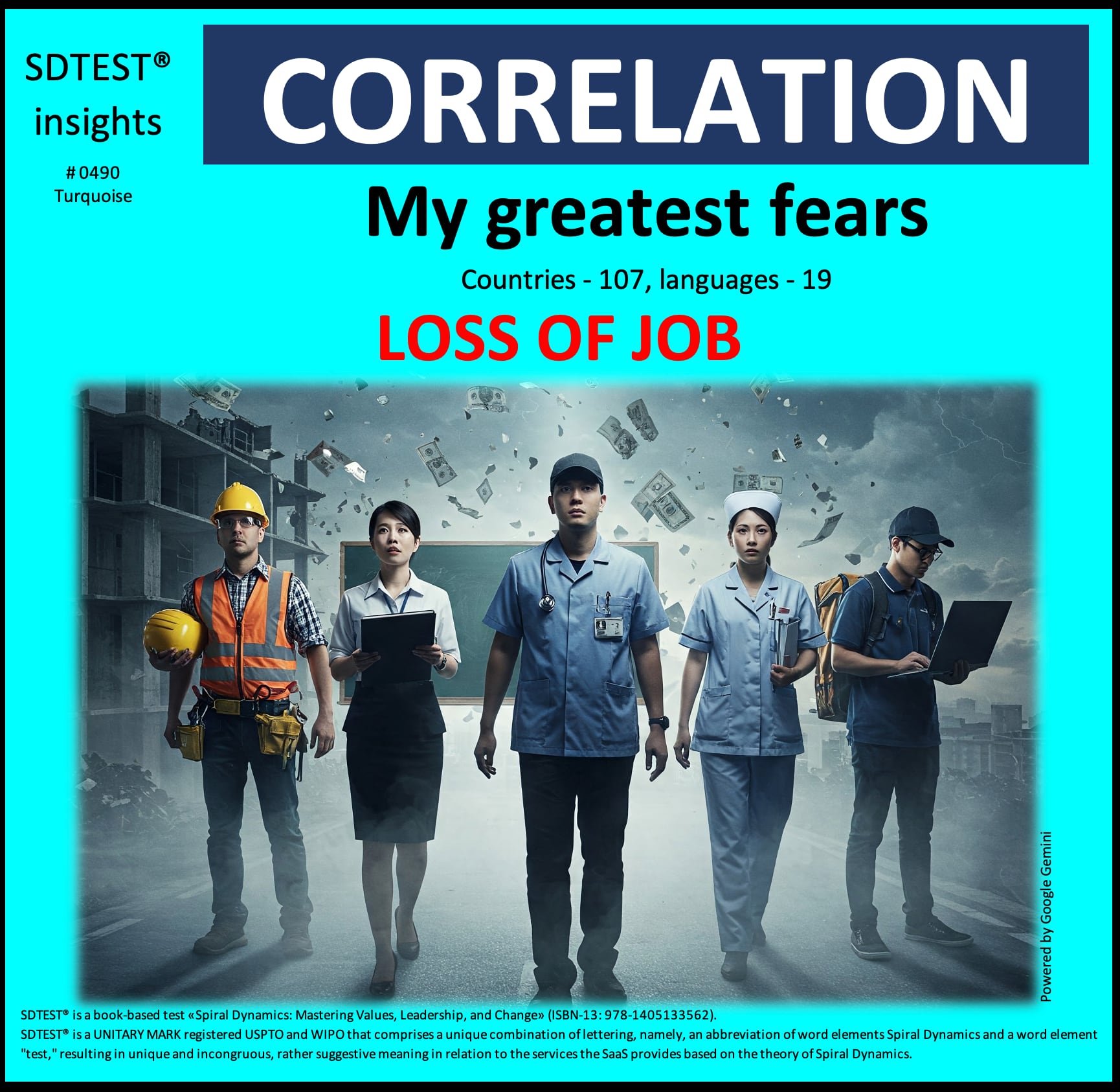
This negative correlation of -0.1643 between Fear of Job Loss and the Turquoise stage offers intriguing insights when viewed through the lens of the Turquoise value system:
Organizational Perspective:
Organizations operating within the Turquoise mindset might interpret this correlation as:
- Validation of their holistic approach to defining success beyond financial metrics and conventional career trajectories.
- Confirmation that their focus on purpose, meaning, and ecological impact creates a more resilient framework for professional fulfillment.
- Evidence supporting their belief that contribution to the greater whole provides security that transcends traditional employment.
These organizations might respond by:
- Implementing fluid organizational structures that allow talent to flow where most needed for systemic well-being.
- Creating work environments that honor the whole person and their multifaceted contributions to interconnected systems.
- Developing regenerative business models that adapt to changing conditions while maintaining ecological and social integrity.
Team Perspective:
Teams operating from a Turquoise mindset might approach this correlation by:
- Viewing it as an affirmation of their trust in collective intelligence and emergent solutions during transitions.
- Interpreting it as supporting their focus on purpose-driven collaboration rather than position security.
- Seeing it as validation for prioritizing meaningful contribution over hierarchical stability.
These teams might respond by:
- Fostering deep trust networks that support members through transitions as natural evolutionary processes.
- Encouraging the development of diverse capacities that serve the whole rather than specialized roles.
- Celebrating the fluid movement of team members as positive for both individual growth and collective wisdom.
Individual Perspective:
Individuals aligned with the Turquoise value system might interpret this correlation as:
- Personal validation of their trust in life's unfolding patterns and their ability to adapt within complex systems.
- Evidence supporting their definition of security as arising from interconnection rather than isolation.
- Confirmation of the value they place on purpose and contribution over position and title.
These individuals might respond by:
- Actively developing capacities that serve the greater whole regardless of formal employment status.
- Viewing career transitions as natural evolutionary processes rather than threats to identity or survival.
- Using periods of employment change as opportunities for deeper alignment with their unique gifts.
This correlation, viewed through the Turquoise lens, suggests that those operating at the Turquoise level may be less likely to fear job loss. It implies that the Turquoise value system's holistic perspective, trust in natural processes, and capacity for seeing interconnections align with a more expansive approach to professional identity and security.
The reasons why Fear of Job Loss might diminish at the Turquoise stage could include:
- Systemic Trust: In the Turquoise stage, there's deep trust in the self-organizing nature of complex systems to provide what's needed.
- Expanded Identity: Professional identity expands beyond specific roles to encompass one's unique contribution to the whole.
- Purpose Orientation: Focus shifts from job security to purposeful contribution, regardless of formal employment structure.
- Abundance Mindset: Recognition of abundant opportunities for meaningful work within interconnected systems.
- Cyclical Perspective: Understanding that periods of transition are natural and generative parts of larger evolutionary cycles.
This correlation prompts us to consider how different value systems influence our relationship to professional security. It raises questions about how more integrated worldviews might fundamentally transform our experience of work and livelihood in increasingly complex global systems.
Ultimately, this correlation highlights the profound shift in perspective that occurs when work is viewed through an ecological and interconnected lens rather than a purely economic or egocentric one.
What insights do you gain from today's correlation? How might we study this relationship more carefully before deducing causation?
We welcome respectful and wise perspectives! Stay tuned every week as we share more results and insights.
After login or registration, free access to the poll results in the FAQ section.
[1] www.linkedin.com/in/nawal-mustafa-84a90591/
2025.05.04
FearpersonqualitiesprojectorganizationalstructureRACIresponsibilitymatrixCritical ChainProject Managementfocus factorJiraempathyleadersbossGermanyChinaPolicyUkraineRussiawarvolatilityuncertaintycomplexityambiguityVUCArelocatejobproblemcountryreasongive upobjectivekeyresultmathematicalpsychologyMBTIHR metricsstandardDEIcorrelationriskscoringmodelGame TheoryPrisoner's Dilemma
Valerii Kosenko
Vörueigandi SaaS SDTEST®
Valerii var menntaður félags- og sálfræðingur árið 1993 og hefur síðan beitt þekkingu sinni í verkefnastjórnun.
Valerii fékk meistaragráðu og verkefna- og námsstjóraréttindi árið 2013. Á meistaranáminu kynntist hann Project Roadmap (GPM Deutsche Gesellschaft für Projektmanagement e. V.) og Spiral Dynamics.
Valerii er höfundur þess að kanna óvissu V.U.C.A. hugtak sem notar Spiral Dynamics og stærðfræðilega tölfræði í sálfræði, og 38 alþjóðlegar kannanir.
